After eating a lot of hard, rubbery, and just all around bad goats milk mozzarella, I finally achieved what I thought was the impossible… I figured out a method that made soft, stringy, tender, and delicious goats milk mozzarella!
You know those 30 minute, microwave, and other quick mozzarella recipes? Skip right over them, don’t even look at them much less waste your milk. They do not work. At least for goat’s milk anyway. Goats milk mozzarella takes a little bit of finesse due to the nature of the milk itself, but it’s fairy inactive with the exception of the stretching and folding step. If you’re really on your game and are properly prepared, this can be made and ready to cook with from start to finish in about an hour and fifteen minutes. Only about 30 minutes of that is actual hands on work.
Your patience will be rewarded with incredibly tender, delicious, and oh so satisfying goat’s milk mozzarella. It will make you love your dairy goats even more, and forget about the kicked milk buckets and temper tantrums on the stand…mostly

Ingredients & Special Materials
- 1 gallon raw goats milk *
- 1.5 teaspoons citric acid
- 1/4 teaspoon QUALITY liquid rennet dissolved in 1/4 cup cool water
- Sea salt
- Brine: 1/2 cup sea salt dissolved in quart of water
- Clean dish gloves ( I have a dedicated pair for cheese making)
- Instant read thermometer
- Cheese skimmer
* I drink my milk raw, so that’s what I use. But, I would imagine it will work just the same with pasteurized.
Directions
- Add goats milk to heavy bottom stockpot over medium heat and bring to 55°F stirring occasionally. Add citric acid, and stir to dissolve
- Continue to heat milk to 90°F, then add rennet + water mixture to milk, stirring in up and down motion for 15 seconds. Cover, remove from heat and let sit for 15 minutes until curd is set, letting sit longer if needed.
- Once curd is set firm, use a long knife to cut parallel lines into the curd to bottom of pot. Turn pot 90° and cut parallel lines perpendicular to the first ones creating small cubes.
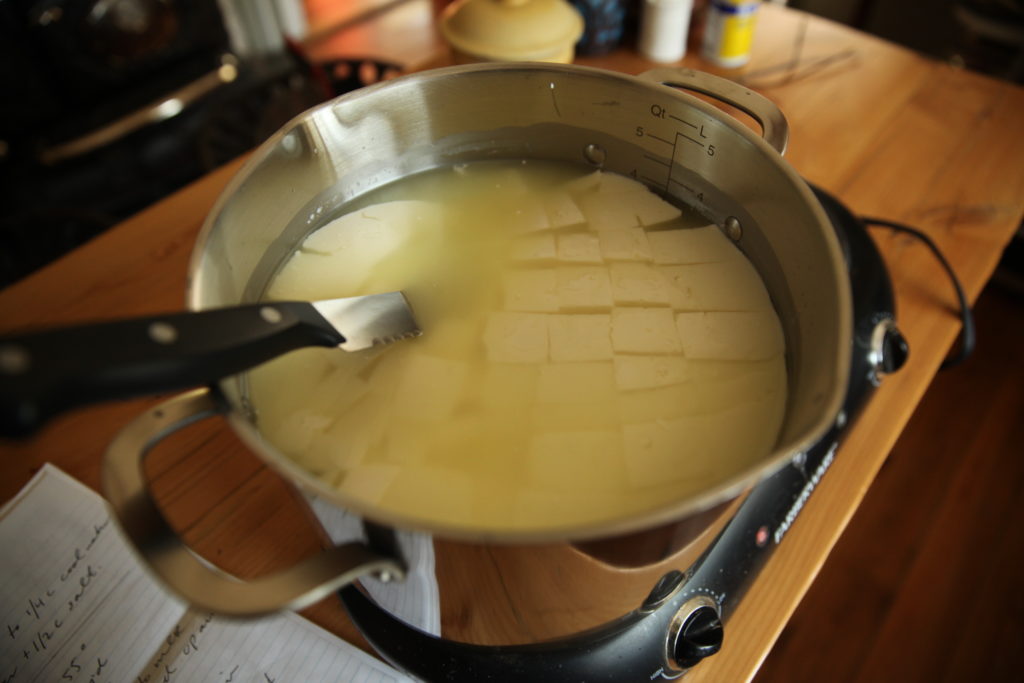
4. Return pot to medium heat and slowly and gently stir curds until their temperature reaches 100°F. Don’t be rough with it! Gentle, gentle, gentle! Once the temperature has been met, remove from heat, cover, and let sit for a half hour or so.
5. After a half hour, remove curds from whey with cheese skimmer to colander over a bowl to collect whey. Add palmful of salt to whey in the stockpot and return to medium high heat until it reaches 160-170°F. Create brine mixture of 1 quart water + 1/2 cup salt dissolved in a bowl and set aside.
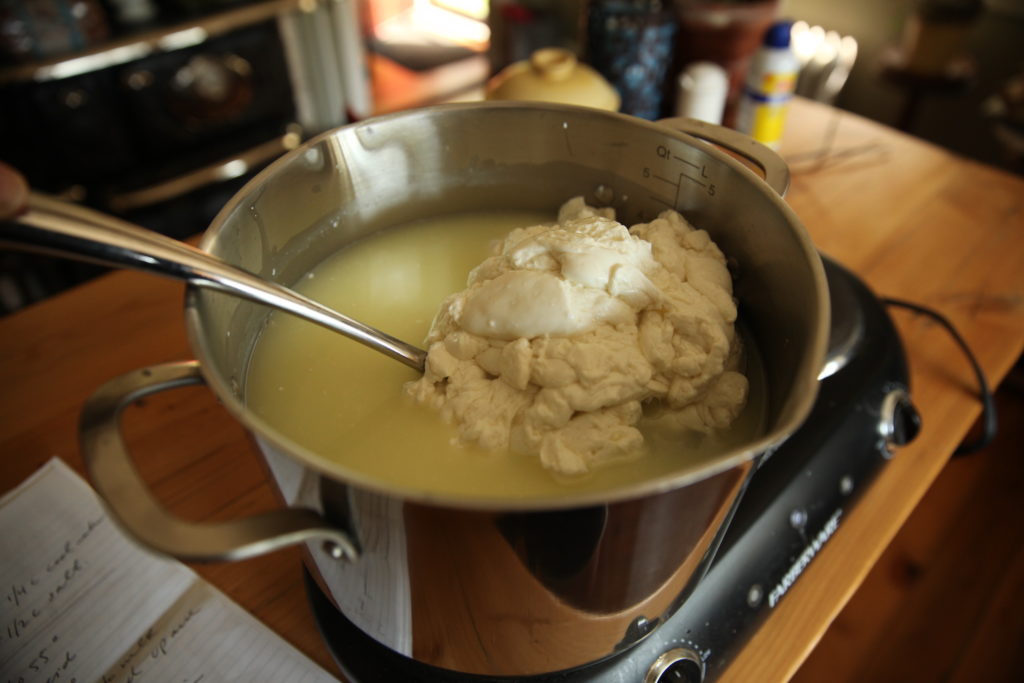
6. Once whey heats up to 160-170°F, working in batches tear off small golf ball-ish sized pieces of curd, and dip and stir around in hot whey. When curds are very hot and soft stretch and fold until it is elastic and doesn’t break. With properly heated whey, this will only require a couple stretches and folds. The cheese should pull and stretch not break and fray. If it does, it needs to go back into the hot whey longer before it’s ready.
DO NOT OVERSTRETCH IT
Make sure the curds have that melty soft texture before stretching. When properly stretched, dip into hot whey again, form into a ball, and add to brine. (**see notes below for tips)
7. Repeat the process with remaining curds, adding each ball of mozzarella to the brine. Use immediately, store in airtight container in brine in the fridge, or wrap and freeze.
**My cheese is technically considered raw, so I use it within a couple days of making it or I will freeze it. If it sits too long, it’s still perfectly fine to eat but it will develop a goaty taste that i’m not a fan of. So I either plan on making it for a meal, or freeze it if I don’t use it within the next couple days!
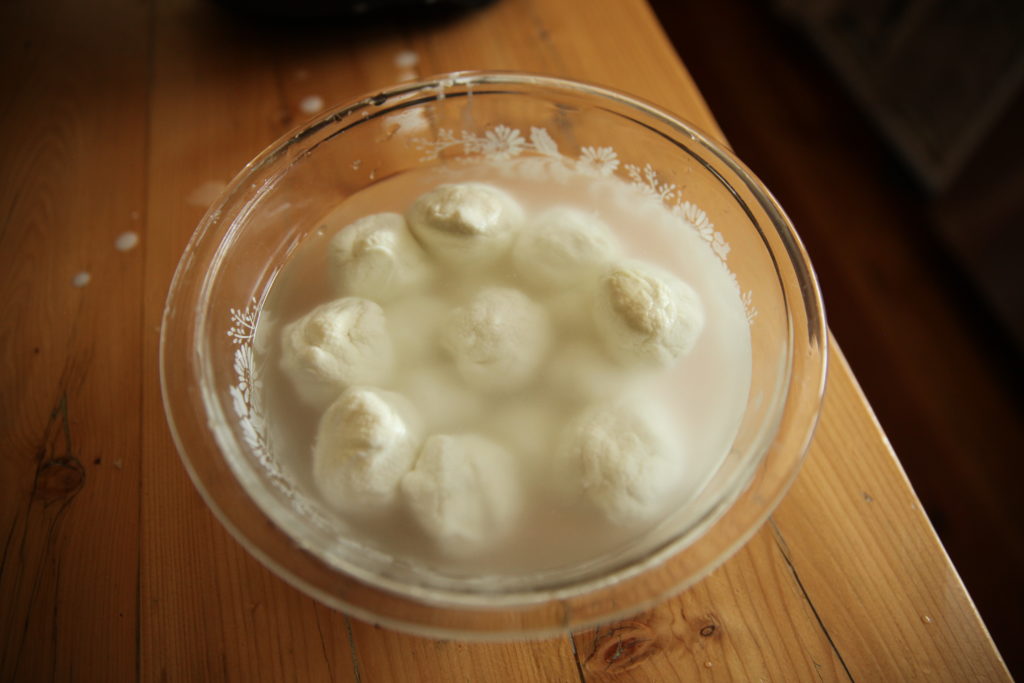
Helpful Hints
Making mozzarella really is a straightforward simple process, but it’s the tiniest details that mean the difference between a hard ball of rubbery cheese and a soft delicate pillow. Seemingly pointless steps like stirring gently in an up and down motion when adding rennet and allowing the curds to sit in the heated whey all contribute to the texture and workability of the cheese.
Goats milk is very different from cows milk or buffalo milk, which I believe is why goats milk mozzarella can be a bit finicky in comparison to other milks. A big part of successful mozzarella comes down to how the milk itself is treated.
Here are some extremely helpful tips that will make all the difference in the world in the outcomes of your cheese:
- Don’t use fresh milk. Mozzarella is best made with milk that is a couple days old (I shoot for 3) versus fresh. This allows the milk to slightly acidify and makes a better curd and better cheese.
- Do not over work the cheese or milk. The gentler you are with the milk when stirring and stretching, the more tender your cheese will be. Before I learned to be gentle and treat it gingerly I had a lot of tough and hard cheese. As soon as I developed a softer hand it made an immediate difference.
- Make sure your whey is very hot. The whey should be extremely hot, which is why you need gloves. You should be able to feel how hot the whey is through the gloves, and it still be hot. Nice and hot whey will make the curds soft and allow it to properly stretch. Whey that’s too cool requires more stretching, which leads to overworked and tough rubbery cheese. DO NOT OVERSTRETCH YOUR CHEESE
- Don’t make your balls too big. Small mozzarella balls are more manageable and will allow you to not overwork it when stretching. With experience you will get more comfortable and can make them bigger. Yeah it’s cool to see professional cheese makers stretch bowling ball sized mozzarella balls. But, they’re professionals, so don’t try to be a superstar right off the bat.
- The Brine: The brine allows salt to properly penetrate the cheese and I believe adds to the tenderness and freshness. I have made it both with and without the brine, and now I always use it. It does certainly add considerable saltiness to the exterior of the cheese, so if you’re eating it fresh or are concerned about accidentally over salting your meal just rinse the ball under cool water and it removes that briny saltiness.
Making mozzarella cheese from your own goats milk is incredibly satisfying and a wonderful addition to any dish. It is a great way to use up a stockpile of milk in the fridge, and while it may get a little drier, it does freeze well. But, chances are you’re planning on melting it, so it’s a non issue and is a great way to preserve fresh cheese throughout the winter!
With this recipe and method, you too can make tender, meltable, and delicious goats milk mozzarella as well! Your first try it likely will not turn out perfect. But, like anything else you will learn..don’t get discouraged! In my quest to find the perfect process for goats milk mozzarella I almost gave up and started making a lot of goats milk ricotta instead (which is phenomenal in its on right). But, persistence (and stubbornness) allowed me to prevail and it is totally worth making a couple bad batches at first.
If you balls turn out a little tough you may look back and be able to pinpoint where you overstretched the cheese or you didn’t let the curd get hot enough in the whey. So, next time make sure you have it good and hot before stretching and you only do it a couple times and don’t go overboard. It’s all part of the learning process, but I assure you this is the recipe and method for successful goats milk mozzarella when done properly!
Happy Cheese Making,

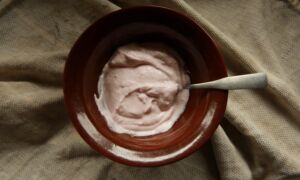
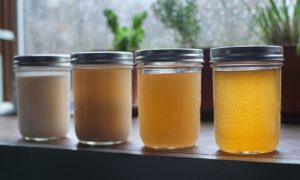
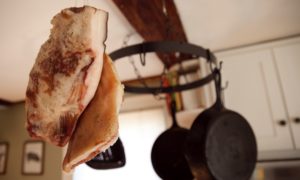
Thank you!! Must try this with the raw goat’s milk we can get at the local co-op. What brand of rennet do you use, and where do you get it? Do you happen to know if the New England Cheesemaking Supply liquid rennet will work well?
EVERYTHING New England Cheesemaking Supply sells is top notch you can’t go wrong with their products! Best of luck to you!
Have you tried making this recipe with lemon juice instead of citric acid? Just went to make it and discovered I am out!
I have not. I would imagine that it or vinegar would work just fine! You just need to acidify it!
Hi Kate!! Don’t cringe butttt is it possible to half this recipe if you don’t have a full gallon? We aren’t getting a lot of milk each day so it’s taking a bit to build up our supply. Thanks!! Jess 🙂
No cringing, work with what you have! Sure you can half it, I just have never worked with less than a gallon so I don’t know how much cheese you’ll end up with!
I so wish I would have stumbled upon this recipe for mozzarella 5 years ago! If you are new to fresh goat milk don’t waste your time looking else where (like I did… five long years of failed mozzarella). By far the best and most simple way to make mozzarella. And I love using the whey instead of the microwave. Thank you Kate! You can bet I will be trying all your recipes now (although I never doubted this recipe after following you on Instagram).
Thank you for the glowing review Jessica!!! I am so happy you found success with it. Those microwave recipes should be called “how to make rubber in 30 minutes”, they’re TERRIBLE!
Just finished up making my first batch! We’re having homemade pizza tomorrow. I was incredibly nervous going in and am still a bit nervous on how it will taste but that is all because of my own insecurities 😂 This recipe and method was fairly easy to follow and execute. My cheese balls *look* like they should. 🤞🤞
HAHA I can relate. Trust me, I made a lot of BAD mozzarella! Each time it gets better! Good news is if it’s a little hard and rubbery, it melts just fine, just not ideal for fresh. Have a wonderful pizza night tomorrow! Let me know how it turns out!
Kate…you are a true treasure to have found! Your recipe worked with my goat milk. Hurray! Thank you for your post.
Inez
from Central Valley, Ca
Reedley